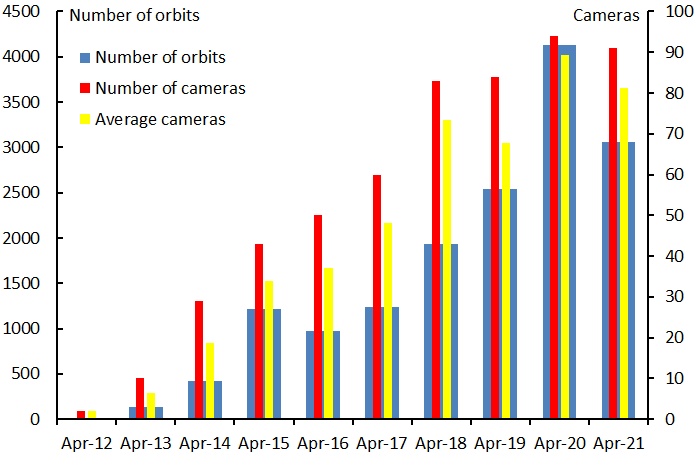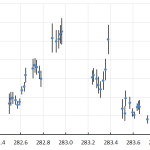Abstract: A summary of the activity of the CAMS BeNeLux network during the month of April 2021 is presented. 3061 orbits were collected during 28 nights with a maximum of 91 operational cameras at 27 different CAMS stations. Favorable weather circumstances during the Lyrid activity allowed to monitor the April Lyrid activity for a fourth year in a row.
1 Introduction
April is often a better month for astronomical observations after a general unfavorable first three months of the year. April also brings the Lyrids, a major annual shower with modest activity apart from some outbursts. CAMS BeNeLux got exceptional favorable observing conditions during the Lyrids 2018, 2019 and 2020, three years on a row. It seemed a bit unlikely to be lucky another year. What would April 2021 bring us?
2 April 2021 statistics
The month started with one clear night followed by 9 mostly cloudy nights. Luckily the weather improved and remained stable until almost the end of the month. As many as 16 nights had more than 100 orbits (same as in 2020, 8 in 2019), 2 nights counted more than 200 orbits (4 in 2020 and 3 in 2019) and the best night was April 22–23 with 339 orbits, still much less than the record night April 21–22 in 2020 with as many as 460 orbits in a single night. Only two nights, April 09–10–11 remained without any orbit. For the fourth year in a row, the CAMS BeNeLux network enjoyed clear sky during much of the Lyrid activity. It would definitely be worthwhile to analyze the data collected about this shower by the network.
CAMS BeNeLux captured 10247 multi-station events (14924 in 2020, 7894 in 2019). April 2021 ended with a very nice result for this month with 3061 orbits in total (compare with 4128 orbits in 2020 and 2534 in 2019). This is the second-best score ever for the month of April in terms of orbits. The maximum of 91 cameras available was slightly less than previous year (94 in 2020 and 84 cameras in 2019). Unfortunately, many cameras remained switched off during a number of nights, reducing the 7 on 7 coverage to 59 cameras (against 76 cameras in 2020 and 44 in April 2019). This is also visible in the average number of operational cameras which dropped from 89.4 operational cameras in 2020 to 81.1 in 2021 (against 67.7 in April 2019). The awareness that meteor camera networks require 7 on 7 coverage is present, but technical issues and private circumstances sometimes prevent volunteers to keep their cameras running all nights.
In total CAMS BeNeLux collected 15646 orbits during 238 April nights accumulated during the past 10 years. The statistics for April 2021 are compared in Table 1 with all previous months of April since the start of the CAMS BeNeLux network. Figure 1 shows the changes in number of orbits and operational cameras compared to previous years.

Figure 1 – Comparing April 2021 to previous months of April in the CAMS BeNeLux history. The blue bars represent the number of orbits, the red bars the maximum number of cameras running in a single night and the yellow bars the average number of cameras running per night.
Table 1 – April 2021 compared to previous months of April.
| Year | Nights | Orbits | Stations | Max. Cams | Min. Cams | Mean Cams |
| 2012 | 6 | 11 | 4 | 2 | 2.0 | |
| 2013 | 19 | 140 | 9 | 10 | 6.5 | |
| 2014 | 19 | 421 | 12 | 29 | 18.8 | |
| 2015 | 27 | 1212 | 15 | 43 | 33.9 | |
| 2016 | 26 | 971 | 17 | 50 | 15 | 37.0 |
| 2017 | 28 | 1235 | 20 | 60 | 32 | 48.2 |
| 2018 | 27 | 1929 | 21 | 83 | 59 | 73.3 |
| 2019 | 29 | 2534 | 20 | 84 | 44 | 67.7 |
| 2020 | 29 | 4128 | 25 | 94 | 76 | 89.4 |
| 2021 | 28 | 3061 | 27 | 91 | 59 | 81.1 |
| Total | 238 | 15646 |
3 Conclusion
2021 brought another month of April with in general favorable weather for the CAMS BeNeLux network. Just like in 2018, 2019 and 2020 clear nights during much of the Lyrid activity period resulted in large numbers of Lyrid orbits.
Acknowledgment
Many thanks to all participants in the CAMS BeNeLux network for their dedicated efforts. The data on which this report is based has been taken from the CAMS website. The data reduction and orbit calculation for all stations is coordinated by Carl Johannink. The CAMS BeNeLux team is operated by the following volunteers:
Hans Betlem (Woold, Netherlands, CAMS 3071, 3702 and 3073), Felix Bettonvil (Utrecht, Netherlands, CAMS 376 and 377), Jean-Marie Biets (Wilderen, Belgium, CAMS 379, 380, 381 and 382), Ludger Boergerding (Holdorf, Germany, RMS 3801), Martin Breukers (Hengelo, Netherlands, CAMS 320, 321, 322, 323, 324, 325, 326 and 327), Guiseppe Canonaco (Genk, RMS 3815), Pierre de Ponthiere (Lesve, Belgium, RMS 3816), Bart Dessoy (Zoersel, Belgium, CAMS 397, 398, 804, 805, 806), Tammo Jan Dijkema (Dwingeloo, Netherlands, RMS 3199), Jean-Paul Dumoulin, Dominique Guiot and Christian Walin (Grapfontaine, Belgium, CAMS 814 and 815, RMS 3814), Uwe Glässner (Langenfeld, Germany, RMS 3800), Luc Gobin (Mechelen, Belgium, CAMS 3890, 3891, 3892 and 3893), Tioga Gulon (Nancy, France, CAMS 3900 and 3901), Robert Haas (Alphen aan de Rijn, Netherlands, CAMS 3160, 3161, 3162, 3163, 3164, 3165, 3166 and 3167), Robert Haas (Texel, Netherlands, CAMS 810, 811, 812 and 813), Robert Haas / Edwin van Dijk (Burlage, Germany, CAMS 801, 802, 821 and 822), Kees Habraken (Kattendijke, Netherlands, RMS 378), Klaas Jobse (Oostkapelle, Netherlands, CAMS 3030, 3031, 3032, 3033, 3034, 3035, 3036 and 3037), Carl Johannink (Gronau, Germany, CAMS 3001, 3002, 3003, 3004, 3005, 3006, 3007, 3008, 3009 and 3010), Hervé Lamy (Dourbes, Belgium, CAMS 394 and 395), Hervé Lamy (Humain Belgium, CAMS 816), Hervé Lamy (Ukkel, Belgium, CAMS 393), Koen Miskotte (Ermelo, Netherlands, CAMS 351, 352, 353 and 354), Tim Polfliet (Gent, Belgium, CAMS 396), Steve Rau (Zillebeke, Belgium, CAMS 3850 and 3852), Paul and Adriana Roggemans (Mechelen, Belgium, RMS 3830 and 3831, CAMS 3832, 3833, 3834, 3835, 3836 and 3837), Hans Schremmer (Niederkruechten, Germany, CAMS 803) and Erwin van Ballegoij (Heesch, Netherlands, CAMS 348).


